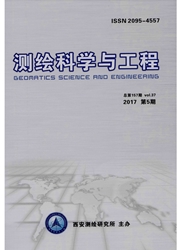

 中文摘要:
中文摘要:
卫星重力反演地球重力场的能力受到卫星轨道高度、数据覆盖率、数据空间分辨率、载荷测量精度等因素影响,除此以外,数学模型的完备性、时空基准一致性、算法的精确性等也会限制重力场测量精度。本文从空间扰动重力数据出发,分析轨道高度、数据分辨率、倾角、测量误差等因素影响重力场恢复能力的规律,通过回避模型误差、算法误差、基准统一误差等因素的影响,更好地揭示重力场测量卫星的潜能。结果表明,在轨道高度500km的条件下,基于扰动重力数据反演地球重力场最高阶为200—210。为充分发挥重力测量卫星的效能,根据需求应尽量选择300—400km的轨道,倾角大于88°,空间数据分辨率优于100km。
 英文摘要:
英文摘要:
The Earth's gravity field recovery ability of satellite gravity is affected by satellite orbit height, data coverage rate, data resolution, payloads precision, etc. Besides, the measurement accuracy of Earth's gravity field might be limited by the integrity of mathematical model, consistency of time-space, accuracy of algorithm and so on. Based on disturbing gravity data, the regularity of Earth's gravity field recovery influenced by orbit height, data resolution, orbit inclination and surveying error is analyzed by avoi- ding influences of errors from mathematical model, algorithm, time-space consistency and so on, and the great potential of gravime- try satellite is revealed in a better way. The results show that the highest order of recovered gravity model based on disturbing gravity data is 200-210 when the orbit height is 500kin. In order to increase the effectiveness of gravimetry satellites, the orbit height should be selected from 300 -400km, with the orbit inclination above 88° and data resolution better than 100km.
 同期刊论文项目
同期刊论文项目
 同项目期刊论文
同项目期刊论文
 期刊信息
期刊信息
